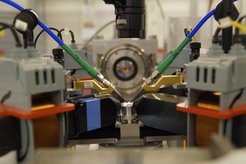Quantum beats for zeptosecond timing
A team of scientists is developing high-precision timing for quantum technologies
Quantum systems will be crucial to future technologies. However, in order to use such systems in practical applications, it is necessary to control and manipulate them with great precision. A research team from DESY and the MPSD has now succeeded in controlling and measuring a quantum system with hitherto unattainable temporal precision on the PETRA III beamline P01. They managed to control and detect oscillations inside an atomic nucleus, as well as the gamma radiation emitted, to within 1.3 zeptoseconds. A zeptosecond is 0.000 000 000 000 000 000 001 seconds; the thousandth part of a billionth of a billionth of a second. The new method developed by the team makes use of the fundamental excitations that occur within a solid. Precise adjustments of this kind are important when building quantum sensors, for example, to establish extremely precise time standards or to detect minute changes. The newly developed method may also have potential applications in quantum computers or quantum communication, as a way of making specific adjustments to such systems.

The scientists obtained their results using the quantum system of an atomic nucleus, specifically the atomic nucleus of the isotope iron-57 (57Fe) embedded in a solid. The solid consists of a thin magnetic film, just a few nanometres thick, containing the iron atoms. The experimenters used a short X-ray pulse from the synchrotron radiation source PETRA III to excite a so-called nuclear resonance in the iron nucleus – this extremely rapid oscillation of the nucleus, with a period of just 287 zeptoseconds, causes the atomic nucleus to emit gamma radiation or X-rays. What is novel about their method for manipulating the atomic nucleus is that, in addition to this they stimulated a second type of oscillation, this time in the surrounding solid. This excitation was achieved using microwaves which caused the entire magnetic system of the solid to oscillate. The magnetic oscillation, known as a magnon, has a period of 0.5 nanoseconds or 500 000 000 zeptoseconds, meaning that it is much slower than the oscillation of the atomic nucleus. Despite this, the second oscillation has an effect on the nuclear resonance of the atom. The magnons in the solid are only excited for a few nanoseconds, so the oscillation in the atomic nucleus only changes for a short time. After the magnon has decayed, the oscillation of the atomic nucleus – and with it the emitted gamma radiation – displays a brief time delay. This delay can be controlled very precisely and has now been measured to within a zeptosecond.
In order to measure such small changes in the first place, the scientists resorted to a trick: they looked at not one, but two different resonances of the atomic nucleus, which emit gamma radiation of slightly different frequencies. When both resonances of the atomic nucleus are excited, beating occurs, in other words the intensity of the emitted gamma radiation fluctuates. Beats occur when two oscillations of slightly different frequencies are superimposed on each other. This results in a periodic increase and decrease in amplitude, i.e. the size of the oscillations. For example, when two sounds of almost the same frequency are played together, the volume appears to rise and fall. The closer the frequencies of the individual notes, the slower this change in volume. The change in volume can be used to deduce how close the frequencies of the two notes are to each other. In this experiment, the beats are purely quantum mechanical, a “quantum beat”. This quantum beat is extremely sensitive to minute time changes in the atomic nucleus. However, the beat itself does not occur on the timescale of zeptoseconds; it varies over a period of nanoseconds and can thus be measured using high-speed photodetectors.
“The magnons give us tremendous flexibility in controlling the quantum system. We adjusted the time delay to the atomic nuclei very specifically using the duration and strength of the magnon excitation. To determine the exact onset of the delay, we shift the timing of the two excitations relative to each other,” says DESY researcher Lars Bocklage, who was in charge of the experiments. From their results, the researchers were also able to determine how reliable this zeptosecond delay is. The delay can be measured to within less than 50 yoctoseconds. A yoctosecond is one thousandth of a zeptosecond – a timescale that is otherwise only encountered with high-energy elementary particles. The precision achieved is, for example, shorter than the lifetime of the Higgs boson.
The experiments mark a first step towards using this novel method of controlling an embedded quantum system by exciting the surrounding solid. Apart from magnon excitation, a number of other solid-state excitations exist, which the group now intends to test, such as oscillations of the crystal lattice or the electrons. The method could also be applied to quantum systems that are already being considered for quantum computers, such as nitrogen vacancy centres in diamonds or ion-doped solids.












